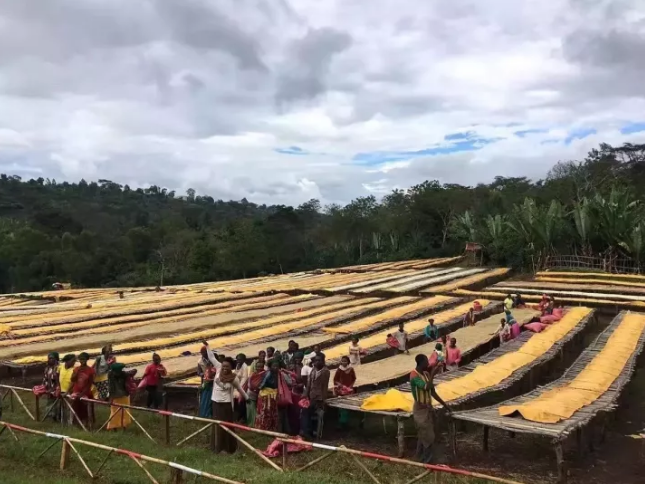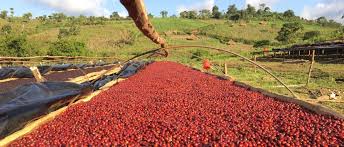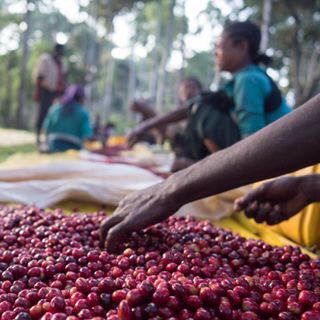Humbera Sakuran, the boutique coffee producing area of Humbera Coffee, the New pre-season Coffee in 2021
Ethiopian Sidamo Shakisso Natural
Huakui
| 01 | production area profile |
Humbera Hambela village-level treatment plant is located in Guji, Guji District. Humbera has grown rapidly in quantity and quality in recent years, and has obtained organic certification. The washing and sun-drying batches of coffee produced have the characteristics of good cleanliness. Humbera Farm is run by METAD Agricultural Company. METAD was founded after World War II and is now the third generation operator Aman Adinew. Under the leadership of Aman, METAD has a stronger structure, employing a large number of domestic employees in Esopia, especially more than 70% women, and joining Grounds for Health, allowing employees to enjoy complete health check-ups, including cervical check-ups for female employees. METAD also provides technical guidance to farmers and lends modern farming equipment, and has set up a laboratory authorized by the American Fine Coffee Association SCAA to specialize in coffee-related professional and technical training.
Hambella (commonly translated as Humbela) is located in GUJI, the largest coffee producing region in Ethiopia, and the administration is subordinate to the state of Oromia. The west of Hambella is across the mountain from kochore. The two producing areas are separated by highlands with an elevation of 3200 meters and a width of about 30 kilometers, and are connected with the shakiso,Uraga and Kerchaz producing areas of Guji in the east and south, respectively. It is the highest coffee producing area in Ethiopia (Harrar is the main producing area in Ethiopia).
At present, there are about 20 processing plants of various sizes in Hambella producing areas. Dimtu, the core production area of Hambella of DW Company, has four manor processing plants, namely "Buku abel", "Buku saysay", "Haro soresa" and "Tirtiro Goye".
Of all these estates and processing plants, only the sun-tanned coffee from the "Buku Abel" manor and processing plant is called "Sakuran".
Buku Abel is a small village surrounded by mountains on the African continent at an altitude of 2280 meters. December is its coffee harvest season. Whenever the mountains are covered with red and mature coffee cherry, the village is neatly arranged on African tanning beds. This is where "Sakuran" deals with.

Bean information
Product name: Ethiopia Sunshine Sidamo G1 Sakuran
Ethiopian Sidamo Shakisso Natural
Coffee producing countries: Africa Africa, Ethiopia Ethiopia
Coffee Manor: Guji Guji, Hambella Wamena area, Dimtu City, buku able Manor
Coffee variety: Heirloom, native to Ethiopia
Production altitude: 2250-2350m
Quality level: G1
Treatment: Natural tanning (African drying bed)
Hambella farmers grow coffee up to 1900 ~ 2200 meters above sea level, and the average low temperature makes coffee beans hard. In addition, this batch of sun-dried beans are dried slowly in a single layer, which makes the flesh sweeter and creates an extraordinary flavor. Rich tropical fruit flavor, citrus, pineapple juice, red wine aroma, peach, mango and strawberry jam sweet and sour, with lavender, blueberry and some micro cocoa aromas Medium baking is also very suitable for making single concentrated products to taste the creamy and fruity flavor!

02 | processing method
In the harvest and treatment season (December-January), its unique growth environment and natural climate created the unique flavor of Huakui. The sugar content of the red fructose we are picking is more than 30 before we start sun treatment. In the first two days of the sun, it is necessary to ensure the humidity of the red fruit so that its fructose fully begins to ferment. At the same time, the high-altitude geographical location, so that the night temperature of the treatment plant can be reduced to about 12 degrees Celsius, and will not produce the smell of excessive fermentation because the temperature is too high. When the temperature is relatively high at noon, we will cover in time to prevent sunburn of red fruit.
From the beginning of cultivation, it has been chosen as a noble "family environment"-rich humus reddish brown soil, and given shade and care to "Enset" tree species, so that Sakui receives sufficient sunlight and produces rich flavor without consuming too much nutrients, thus retaining more essence in the inside of the coffee fruit.

Choose only all red fruits, fully ripe coffee cherries, all manual picking, African scaffolding to dry, limit the thickness of the fruit layer and turn it regularly for 24 hours to ensure uniform sun exposure and ventilation and a more accurate grasp of the fermentation degree.
In order to prevent sudden rain at night, it will be wrapped in thick plastic sheeting. In this way, the red fruit is fermented and dehydrated at a lower temperature. After 18 days of sun treatment, when the moisture content of raw coffee beans is reduced to about 13%, stop sun treatment, put it in sacks, put it in the warehouse under natural conditions of 12-22 degrees Celsius and 40-50% humidity, raise raw beans and further dehydrate for about 50 days. When the moisture content of raw beans reaches about 10, the transportation treatment plant will be shelled and screened for sale.
03 | Analysis of raw beans
The varieties are native species, small granule species, with a round appearance and a small bean body, mostly between 14 and 15 orders.
Sun Sidama: the bean body is smaller than Longberry and yellowish in green. There is a great difference in particle size.
Washed Sidamo: coffee raw bean green with a slight cyan color. There is a great difference in particle size.

Hambella (commonly translated as Humbela) is located in GUJI, the largest coffee producing region in Ethiopia, and the administration is subordinate to the state of Oromia. The west of Hambella is across the mountain from kochore. The two producing areas are separated by highlands with an elevation of 3200 meters and a width of about 30 kilometers, and are connected with the shakiso,Uraga and Kerchaz producing areas of Guji in the east and south, respectively. It is the highest coffee producing area in Ethiopia (Harrar is the main producing area in Ethiopia).
At present, there are about 20 processing plants of various sizes in Hambella producing areas. Dimtu, the core production area of Hambella of DW Company, has four manor processing plants, namely "Buku abel", "Buku saysay", "Haro soresa" and "Tirtiro Goye".
Of all these estates and processing plants, only the sun-tanned coffee from the "Buku Abel" manor and processing plant is called "Sakuran".
Buku Abel is a small village surrounded by mountains on the African continent at an altitude of 2280 meters. December is its coffee harvest season. Whenever the mountains are covered with red and mature coffee cherry, the village is neatly arranged on African tanning beds. This is where "Sakuran" deals with. Ethiopian Sidamo Shakisso Natural
Huakui
| 01 | production area profile |
Important Notice :
前街咖啡 FrontStreet Coffee has moved to new addredd:
FrontStreet Coffee Address: 315,Donghua East Road,GuangZhou
Tel:020 38364473
- Prev

China's local coffee brand-Pacific Coffee joins Pacific Coffee what is the best?
For more information on coffee beans, please follow the Coffee Workshop (Wechat official account cafe_style) Pacific Coffee, a Hong Kong cafe with a slightly artistic and serious appearance. Since entering the mainland in 2011, it has opened 164stores (307stores worldwide), becoming the only one from the United States.
- Next

Coffee accompanies you official website _ coffee accompanies you join fee is high coffee accompanies you, still can accompany you how long?
= "Coffee accompany you official website" = = Professional coffee knowledge exchange more coffee bean information please follow the coffee workshop (Wechat official account cafe_style) Coffee accompany you (caffebene) is the largest coffee chain brand from Korea, headquartered in Qingtaandong, Gangnam District, Seoul. Since its rise in South Korea in 2008, it has reached 80% in Korean chain stores by July 2012.
Related
- What documents do you need to go through to open a coffee shop? coffee shop coffee shop certificate processing process
- How to purchase Coffee beans in small Cafe how to choose a suitable supplier for domestic Coffee supply Company
- How to drink Starbucks Fragrance White Coffee? how to make Australian White Coffee? what Italian coffee beans are recommended?
- The Story of Flora Coffee: the name of Flora Coffee Bean and the implication of the Flowers on Florna Coffee
- How much does a cup of coffee cost? How much is the profit of a cup of coffee? What is the profit of the coffee shop in a year?
- Yunnan small Coffee, known as "fragrant Coffee", introduces the characteristics of Alpine Arabica Coffee producing areas in Yunnan, China
- 2023 latest Starbucks full menu price list how much is a cup of Starbucks coffee what is better to drink the most popular hot and cold drinks recommended
- Starbucks different kinds of Coffee Price list Starbucks menu 2023 Top Ten Best drinks in Starbucks
- Starbucks Spring praise Comprehensive matching Coffee Bean theme Story Packaging implication and taste description
- The cost of a cup of coffee latte American coffee cost price and selling price

